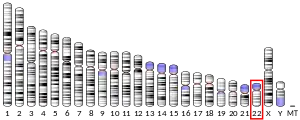Ataxin 10
Ataxin-10 is a protein that in humans is encoded by the ATXN10 gene.[4][5]
| ATXN10 | |||||||||||||||||||||||||
|---|---|---|---|---|---|---|---|---|---|---|---|---|---|---|---|---|---|---|---|---|---|---|---|---|---|
| Identifiers | |||||||||||||||||||||||||
| Aliases | ATXN10, E46L, HUMEEP, SCA10, ataxin 10 | ||||||||||||||||||||||||
| External IDs | OMIM: 611150 MGI: 1859293 HomoloGene: 40858 GeneCards: ATXN10 | ||||||||||||||||||||||||
| |||||||||||||||||||||||||
| |||||||||||||||||||||||||
| Orthologs | |||||||||||||||||||||||||
| Species | Human | Mouse | |||||||||||||||||||||||
| Entrez | |||||||||||||||||||||||||
| Ensembl | |||||||||||||||||||||||||
| UniProt | |||||||||||||||||||||||||
| RefSeq (mRNA) | |||||||||||||||||||||||||
| RefSeq (protein) | |||||||||||||||||||||||||
| Location (UCSC) | Chr 22: 45.67 – 45.85 Mb | n/a | |||||||||||||||||||||||
| PubMed search | [2] | [3] | |||||||||||||||||||||||
| Wikidata | |||||||||||||||||||||||||
| |||||||||||||||||||||||||
Clinical significance
The autosomal dominant cerebellar ataxias (ADCAs) are a clinically and genetically heterogeneous group of disorders characterized by ataxia, dysarthria, dysmetria, and intention tremor. All ADCAs involve some degree of cerebellar dysfunction and a varying degree of signs from other components of the nervous system. A commonly accepted clinical classification (Harding, 1993) divides ADCAs into 3 different groups based on the presence or absence of associated symptoms such as brainstem signs or retinopathy. The presence of pyramidal and extrapyramidal symptoms and ophthalmoplegia makes the diagnosis of ADCA I, the presence of retinopathy points to ADCA II, and the absence of associated signs to ADCA III. Genetic linkage and molecular analyses revealed that ADCAs are genetically heterogeneous even within the various subtypes.[5]
Defects in ATXN10 have been associated with Joubert syndrome.[6]
References
- GRCh38: Ensembl release 89: ENSG00000130638 - Ensembl, May 2017
- "Human PubMed Reference:". National Center for Biotechnology Information, U.S. National Library of Medicine.
- "Mouse PubMed Reference:". National Center for Biotechnology Information, U.S. National Library of Medicine.
- Zu L, Figueroa KP, Grewal R, Pulst SM (Apr 1999). "Mapping of a new autosomal dominant spinocerebellar ataxia to chromosome 22". Am J Hum Genet. 64 (2): 594–9. doi:10.1086/302247. PMC 1377770. PMID 9973298.
- "Entrez Gene: ATXN10 ataxin 10".
- Sang L, Miller JJ, Corbit KC, et al. (May 2011). "Mapping the NPHP-JBTS-MKS protein network reveals ciliopathy disease genes and pathways". Cell. 145 (4): 513–28. doi:10.1016/j.cell.2011.04.019. PMC 3383065. PMID 21565611.
Further reading
- Harding AE (1993). "Clinical features and classification of inherited ataxias". Advances in Neurology. 61: 1–14. PMID 8421960.
- Ashizawa T, Matsuura T (2002). "[Spinocerebellar ataxia type 10 (SCA10): a disease caused by a novel pentanucleotide repeat expansion]". Rinsho Shinkeigaku. 41 (12): 1120–2. PMID 12235814.
- Grewal RP, Tayag E, Figueroa KP, et al. (1998). "Clinical and genetic analysis of a distinct autosomal dominant spinocerebellar ataxia". Neurology. 51 (5): 1423–6. doi:10.1212/wnl.51.5.1423. PMID 9818872.
- Dunham I, Shimizu N, Roe BA, et al. (1999). "The DNA sequence of human chromosome 22". Nature. 402 (6761): 489–95. doi:10.1038/990031. PMID 10591208.
- Matsuura T, Yamagata T, Burgess DL, et al. (2000). "Large expansion of the ATTCT pentanucleotide repeat in spinocerebellar ataxia type 10". Nat. Genet. 26 (2): 191–4. doi:10.1038/79911. PMID 11017075.
- Wiemann S, Weil B, Wellenreuther R, et al. (2001). "Toward a catalog of human genes and proteins: sequencing and analysis of 500 novel complete protein coding human cDNAs". Genome Res. 11 (3): 422–35. doi:10.1101/gr.GR1547R. PMC 311072. PMID 11230166.
- Simpson JC, Wellenreuther R, Poustka A, et al. (2001). "Systematic subcellular localization of novel proteins identified by large-scale cDNA sequencing". EMBO Rep. 1 (3): 287–92. doi:10.1093/embo-reports/kvd058. PMC 1083732. PMID 11256614.
- Fujigasaki H, Tardieu S, Camuzat A, et al. (2002). "Spinocerebellar ataxia type 10 in the French population". Ann. Neurol. 51 (3): 408–9. doi:10.1002/ana.10126. PMID 11891842.
- Strausberg RL, Feingold EA, Grouse LH, et al. (2003). "Generation and initial analysis of more than 15,000 full-length human and mouse cDNA sequences". Proc. Natl. Acad. Sci. U.S.A. 99 (26): 16899–903. doi:10.1073/pnas.242603899. PMC 139241. PMID 12477932.
- Ota T, Suzuki Y, Nishikawa T, et al. (2004). "Complete sequencing and characterization of 21,243 full-length human cDNAs". Nat. Genet. 36 (1): 40–5. doi:10.1038/ng1285. PMID 14702039.
- Matsuura T, Fang P, Lin X, et al. (2004). "Somatic and germline instability of the ATTCT repeat in spinocerebellar ataxia type 10". Am. J. Hum. Genet. 74 (6): 1216–24. doi:10.1086/421526. PMC 1182085. PMID 15127363.
- Collins JE, Wright CL, Edwards CA, et al. (2005). "A genome annotation-driven approach to cloning the human ORFeome". Genome Biol. 5 (10): R84. doi:10.1186/gb-2004-5-10-r84. PMC 545604. PMID 15461802.
- Gerhard DS, Wagner L, Feingold EA, et al. (2004). "The status, quality, and expansion of the NIH full-length cDNA project: the Mammalian Gene Collection (MGC)". Genome Res. 14 (10B): 2121–7. doi:10.1101/gr.2596504. PMC 528928. PMID 15489334.
- Matsuura T, Fang P, Pearson CE, et al. (2006). "Interruptions in the expanded ATTCT repeat of spinocerebellar ataxia type 10: repeat purity as a disease modifier?". Am. J. Hum. Genet. 78 (1): 125–9. doi:10.1086/498654. PMC 1380209. PMID 16385455.
- Waragai M, Nagamitsu S, Xu W, et al. (2006). "Ataxin 10 induces neuritogenesis via interaction with G-protein beta2 subunit". J. Neurosci. Res. 83 (7): 1170–8. doi:10.1002/jnr.20807. PMID 16498633.
- Ewing RM, Chu P, Elisma F, et al. (2007). "Large-scale mapping of human protein-protein interactions by mass spectrometry". Mol. Syst. Biol. 3 (1): 89. doi:10.1038/msb4100134. PMC 1847948. PMID 17353931.
External links
- GeneReviews/NCBI/NIH/UW entry on Spinocerebellar Ataxia Type 10
- Human ATXN10 genome location and ATXN10 gene details page in the UCSC Genome Browser.

